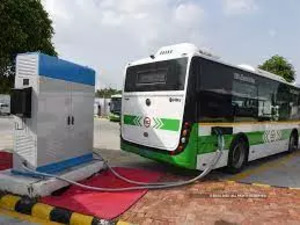Medilytix Bureau : The Centre is seeking to replace up to 30,000 diesel-run polluting buses with electric powertrain vehicles in the next 2-3 years, marking India’s giant leap toward clean mobility and offering bus makers a $3.5-billion business opportunity. Convergence Energy Services Limited (CESL)—the state-run company that handles the acquisition of EVs for central and state government departments—said the size of the programme could expand more than three-fold over time.
CESL managing director Mahua Acharya told ET that buses are an area of the highest impact, socially and environmentally, with the potential to expand the EV fleet size to about 100,000 units. “It (100,000 units) is very much doable. ” Switching public transport buses to electricity would substantially help in reducing crude imports, which is a priority for the government,” said Acharya.
In the meantime, the “qualified demand” is for 25,000-30,000 buses. We do a depot assessment, check transformers, study routes, and then aggregate the demand across states to lower costs through scale, “she said.
In the meantime, the “qualified demand” is for 25,000-30,000 buses. We do a depot assessment, check transformers, study routes, and then aggregate the demand across states to lower costs through scale, “she said.
Even without incentives, aggregating demand on a gross cost contracting model from across states helped realise 27% and 23% lower rates for electric buses compared to diesel-driven and compressed natural gas-run ones in the tender floated by CESL in January 2022. More than 1.6 million buses ply the Indian roads every day—most running on diesel. Of these, the buses run by state transport undertakings (STUs) make up about 10%. The majority of these buses, operated by STUs, are running into losses. CESL has ensured a profitable route for STUs by introducing a gross cost contract model that not only ensures a cleaner environment but also viable operations.
Various streamlining and risk reduction measures helped enhance competition and led to the record low prices of 39.21/kilometer for 9-meter e-buses and 43.49/kilometer for 12-meter low-floor e-buses (including the cost of charging).
Various streamlining and risk reduction measures helped enhance competition and led to the record low prices of 39.21/kilometer for 9-meter e-buses and 43.49/kilometer for 12-meter low-floor e-buses (including the cost of charging).
Acharya said while this asset-light model has made it possible for ailing STUs to deploy affordably and at scale, challenges do remain regarding the availability of adequate power supply at depots for charging buses proposed for induction. State governments would have to invest in upgrading grids to ensure an adequate load for charging electric vehicles.
This cost (of upgrading transformers and cable lines) cannot be socialised. Another important aspect that will help fast-forward EV adoption is the availability of financial risk mitigation instruments, “she said.


